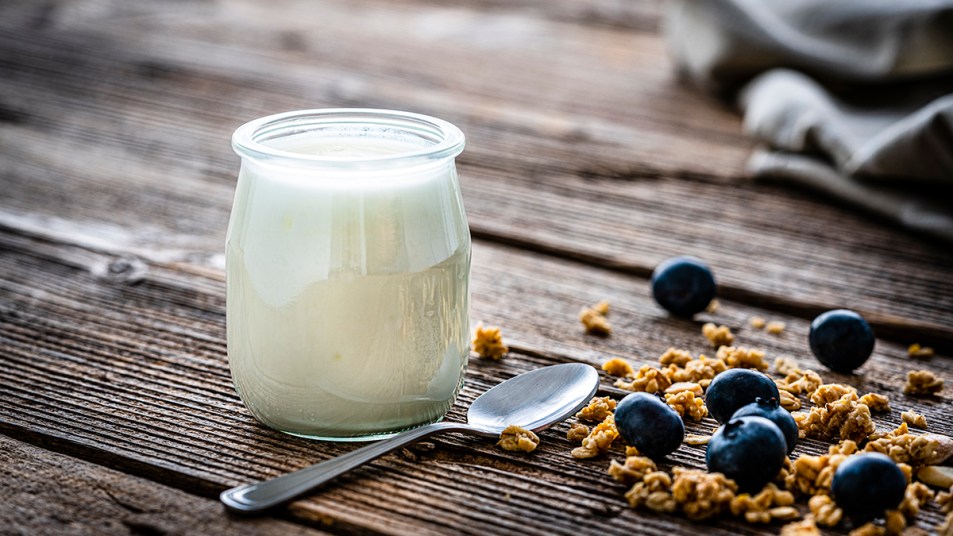This SIBO Yogurt May Be the Delicious Cure For Bloating, Blue Moods and GI Discomfort You’ve Been Waiting For
Dr. William Davis assures that it works for 90% of women with SIBO — and it's easy and affordable

Many women who experience bloating, constipation and depression write it off as just the natural result of aging — and unfortunately so do their doctors! — but there’s growing evidence that a condition called SIBO (small intestinal bacterial overgrowth) is impacting many more people than previously thought. “I refer to SIBO as ‘Frankenbelly’ because it’s a modern-day health monster,” says gut-health expert William Davis, MD, who maintains that SIBO affects more people than pre-diabetes and type 2 diabetes combined. He explains that the disorder can manifest in a myriad of ways: from all-body achiness to restless leg syndrome to chronic fatigue, and of course, a full array of GI symptoms. The good news is that there are SIBO natural treatments that are astonishingly effective at easing symptoms. Read on to learn more about SIBO and the new arsenal of natural treatments available to treat it — plus how Dr. Davis’ approach helped one woman with SIBO restore her health.
What is SIBO?
To understand SIBO, you need to first understand that there are two very distinct parts of your GI tract: the large intestine and the small intestine.

Different kinds of microscopic bacteria and fungus generally take up residence in the different parts of the intestinal tract. When they don’t stay where they belong? That’s when the trouble starts. “Triggered by a combination of factors — from processed foods to antibiotics to acid-blocking drugs — SIBO occurs when gut bacteria that belong in the colon overgrow and spread to the small intestine,” explains Dr. Davis, author of Super Gut and the bestselling Wheat Belly books. “In the small intestine, these microbes produce toxins that leak into the bloodstream and cause abdominal pain and distention, brain fog, depression and weight gain.”
SIBO affects at least one-third of women, asserts women’s health expert Ann Louise Gittleman, PhD, author of Why Am I Always So Tired? Not only are mainstream doctors not well-informed about the condition, Gittleman maintains, “Doctors aren’t looking for SIBO, and they often mistake the condition for other things, like stress or depression.” As a result, most women are never diagnosed.
What causes SIBO?
The number one cause of any kind of chronic disruption of the GI system is antibiotics. “Antibiotics are like a hydrogen bomb set off in the GI tract that leaves a path of microbial devastation,” writes Dr. Davis in Super Gut. In the wake of a course of antibiotics, it’s much easier for microbes to migrate from the large intestine to the small intestine. Consumption of refined sugar also triggers rapid changes in your intestinal flora, causing loss of critical “good guys” in as little as three days. Artificial sweeteners, especially aspartame, saccharine and sucralose, are all implicated in disrupting your inner bacterial landscape. Frequent use of nonsteroidal anti-inflammatory drugs (NSAIDS) like Advil, are additionally implicated as are pesticides that we ingest with our food.
How to know if you have SIBO
While SIBO affects men and women equally, women are more likely than men to suffer from constipation than diarrhea. “The classic symptom profile is, you wake up and don’t know if you’ll have a bowel movement that day or how many or what they’ll look like,” explains gastroenterologist Mark Pimentel, MD. “If that’s you, chances are over 90% that you have SIBO.”
If you suspect you might have the condition (most people who have irritable bowel syndrome also have SIBO), you can ask your healthcare provider to order a lactulose breath test, which helps determine if you have an overgrowth of bacteria. Dr. Davis admits that this formal breath testing can be a hassle — there’s day-before prep, and frequent sample collection and then, of course waiting for results. To simplify things, Dr. Davis recommends using an AIRE device for breath testing at home. While this device costs about $200, it’s very easy to use and can save money over the long term. (Click through to discover if SIBO is making you tired.)
What are the best natural treatments for SIBO?
If the tests above are positive, the traditional treatment typically includes the prescription antibiotic rifaximin and a diet high in simple carbohydrates (which are easier to digest) and low in beans, leafy greens and dairy (which are more difficult to digest).
Dr. Davis maintains, however, that if you have symptoms like brain fog, bloat, gas, upset stomach, diarrhea, rashes, blue moods, anxiety and weight gain, the steps below can eliminate overgrowth and restore energy within four weeks.
1. Nosh on SIBO yogurt daily
Replenishing good gut bacteria is key. But most probiotics don’t contain the bacteria that heal SIBO, cautions Dr. Davis. That’s why he advises a daily dose of a homemade yogurt made with specific strains. Why won’t just any yogurt do? Store-bought yogurt is made with cheap probiotics and is fermented just 4 hours,” notes Dr. Davis. When you make yogurt his way, you use high-quality probiotics and ferment them in cream (right on your countertop) for 36 hours. “Instead of yogurt with 3 billion so-so probiotics, you’ll have 300 billion of the very best probiotics.” And that’s why DIY yogurt delivers huge benefits. For example, strains the doctor recommends (see recipe and how-to’s below) are linked to better mood, faster fat burn, rapid hair growth, youthful skin, accelerated healing, super immunity, lower stress, reversal of age-related bone and muscle loss, plus much more.
“Commercial probiotic supplements are getting better, but for now, my yogurt is your best bet,” says Dr. Davis. “It has a greater quantity of probiotics than most supplements, and there’s no capsule or coating, so the probiotics get into your system faster and more easily.”
Dr. Davis’ patients report that weight loss becomes effortless and they shed up to 23 pounds in two weeks. “Plus, wrinkles disappear, mood soars, sleep deepens and health problems fall away,” he says. “It’s really enough to turn back the clock 20 years!”
2. Supplement with curcumin
Antibacterial curcumin supplements can help. Dr. Davis advises taking 300 mg. twice daily, doubling the dose over a week. Then supplement at that level for four to six weeks. He notes that it’s crucial that curcumin remains in the GI tract as long as possible, so pick a product that isn’t formulated to enhance absorption, like Thompson Curcumin 300 mg (buy on Amazon, $16.97 for 60).
Anti-inflammatory compounds in curcumin, which gives turmeric spice its vivid hue, help the small intestine heal. Plus, they have an antifungal action. That’s key since SIBO is often accompanied by small intestinal fungal overgrowth (SIFO).
3. Reach for olive oil
“You can’t overdo consumption of extra-virgin olive oil,” says Dr. Davis, who recommends using it in salad dressings and drizzling it over veggies, pizza and even scrambled eggs. The body converts oleic acid found in the oil to oleoylethanolamide (OEA), a unique substance that enhances the strength of the gut lining.
4. Swap your sweetener
Sugary fare is a top SIBO trigger. In a Mayo Clinic study, folks who ate diets high in sugar developed bacterial overgrowth within seven days. But Dr. Davis says artificial sweeteners can also cause bacterial imbalances that set SIBO in motion. His advice: Use monk fruit, which contains mogrosides that tame gut-damaging inflammation. Also smart: avoiding grains such as wheat, corn, barley and rye when possible. They can fuel overgrowth since they break down into sugar during digestion.
SIBO natural treatment: Dr William Davis’ yogurt
“A yogurt made with specific probiotic strains has eased SIBO symptoms in 90% of my patients,” says Dr. Davis. He advises enjoying 1⁄2 cup daily for at least four weeks.
Yogurt making 101
To get started, you’ll need a device that can maintain 106°F for 36 hours. That’s the perfect time and temperature to ferment your ingredients and create the most potent results. (If it’s too cold, the probiotics won’t grow; if it’s too hot, they die.)
Dr. Davis’ devotees report getting best results with a sous vide gadget, which provides a precisely heated water bath and not only makes yogurt but also perfectly cooks veggies and meat. We like the Instant Accu Slim Sous Vide 800W Precision Cooker (buy on Amazon, $99.99)
Prefer a cheaper option? Go for a yogurt maker that lets you fully control time and temperature, like Suteck (buy on Amazon, $42.99). You may want to use a thermometer to test the yogurt temperature after it’s fermented an hour; adjust if it gets too hot.
Once you have your device, simply follow the recipe below. Enthuses Dr. Davis, “I have made countless batches of this without a single failure. You absolutely can do this!”
How to make Dr. Davis’ SIBO yogurt
To make SIBO yogurt, you’ll need 1 quart of organic half-and-half and the ingredients below:
- 1 capsule Lactobacillus gasseri strain BNR17 (try: Dr. Mercola Biothin, buy on Amazon, $26.07 for 30 capsules)
- 10 tablets Lactobacillus reuteri strains DSM 17938 and ATCC PTA 6475, crushed (try: BioGaia Gastrus, buy on Amazon, $24 for 30 tablets)
1 capsule Bacillus coagulans strain GBI-30,6086 (try: Schiff Digestive Advantage Daily Probiotic buy on Amazon, $24 for 80 capsules) - 2 Tbs. raw potato starch (try: Bob’s Red Mill Potato Starch, buy on Amazon, $7.88 for 22 oz.)
Step 1: Stir together probiotics, potato starch and 2 Tbs. of milk/cream until dissolved (this prevents starch from clumping). Stir in remaining liquid.
Step 2: Divide mixture among glass jars that fit in your device (or a large pot for sous vide method). Cover jars loosely with plastic or a mesh screen top.
Step 3: Add jars to yogurt maker or to a pot with water an inch or two from jar tops. Set device to heat at 106ºF for 36 hours.
Click through for more: Never Buy Probiotics Again — Use This Simple Process to Make Yogurt At Home and Boost Your Gut Health
The link between SIBO and klebsiella oxytoca
Many women with SIBO experience additional conditions, like SIFO. That’s a problem since research shows that excess fungi in the intestines can trigger inflammation that worsens symptoms.
Another common infection: klebsiella oxytoca, also known as KO‚ an infection that caused Elisabeth Dunham’s SIBO (read her story below). KO is a bacteria that resides in the intestines naturally without causing problems. But when it migrates out of the large intestines, it can cause a range of infections, from urinary tract infections to pneumonia and more. KO infections commonly occur in hospitals and nursing homes.
Symptoms of a KO infection are slightly different than those of SIBO and include flu-like symptoms like aches, fever, chills and breathing trouble. The good news is that antibiotics can clear the infection and restore health.
“Dr William Davis’ SIBO yogurt gave me my life back!”

Elisabeth Dunham, 56, battled fatigue and GI woes for months before discovering she was dealing with SIBO. But when she started making Dr. Davis’ anti-SIBO yogurt, she finally healed.
“I was in my 50s and in seemingly good health,” recalls Elisabeth. “From the outside, all looked good: I was running a home-based business and working as a freelance automotive writer, and my kids were healthy and doing well. But I worried there was a serious underlying illness. To make matters worse, I was gaining weight as the pandemic raged on, thanks to menopause and the stress of having kids at home learning remotely.
“For one, I wasn’t getting enough sleep. No matter when I went to bed, I woke up at 4 or 5 am with a pain in my gut and was wide-awake. I was a night owl, so that meant I was running on far too little sleep. But even when I did get 8 hours of sleep, the gut pain and digestive stress were jarring.
“Everything from taking a shower to getting dressed seemed like an enormous task. I took short walks and tried to do workouts on TV, but I didn’t always have it in me to exercise more strenuously. The number on the scale kept creeping up. Like everyone else during the pandemic, the quarantine meant being cut off from the world. But my fatigue made the
feeling even worse.
“One day, I hit my breaking point. I had slept all night and still felt exhausted, brain-fogged and lacking in enthusiasm for life. I made an appointment and saw my doctor a week later. When my lab work came back, everything was in the normal range: There was nothing wrong with my gut and no signs of anything more serious.
Elisabeth kept searching for answers
“But because I wasn’t improving, I saw a naturopath and had my stool tested by a company that specializes in finding pathogens in the digestive tract. The first naturopath I’d seen after the tests came back told me I had gastritis and that I should eat a low FODMAP diet, which reduces fermentation in the gut. I tried it, but it didn’t seem to have much impact. When I continued to get worse, I showed my results to a second naturopath and she saw something the other physician had missed: Klebsiella oxytoca, a bacteria linked with small intestinal bacterial overgrowth (SIBO) and various gut issues. Knowing I didn’t want to take antibiotics due to overuse of them in my past, the naturopath said that certain strains of probiotics might help.
The reuteri yogurt that changed everything
“I did my own research and found an interview with Dr. Davis. He had discovered something called SIBO yogurt, made from three specific strains of probiotics that are shown to eliminate the bad bacteria associated with SIBO.
“I read an article on his website that outlined which brands carried the exact strains of probiotics I needed. He wasn’t associated with any of the brands he was suggesting, so I felt safe that there wasn’t a conflict of interest. I purchased the ingredients to make it and found videos on YouTube that showed how to make Dr. Davis’ SIBO yogurt.
“I felt reassured hearing Dr. Davis say most people with SIBO healed within a month eating 1/2 cup of the yogurt per day, so I made a vegan version of it using coconut cream instead of half-and-half. I blended it into smoothies and stirred it into lukewarm oatmeal to hide the taste. Within a few days, my gut was improving and I was sleeping better. Within a week, the pain was gone and I was able to sleep through the night.
Elisabeth is thriving today
“After a month, I decided to recheck my gut health, and the test showed no sign of the klebsiella infection. I was thrilled to have found an answer, and as a certified nutrition counselor with my own practice, excited to have a remedy that didn’t involve harsh medications that I could share with clients.
“Another exciting outcome: I was able to exercise again and shed a few pounds. I have my life back! I’m enjoying parenting my teens, exercising, seeing friends and writing and working as a nutrition consultant though my website, ElisabethDunhamHealth.com. I learned that we don’t have to just survive as we age. We can thrive!”
Read on for more stories of women overcoming gut health issues:
“After 15 Years of GI Issues, I Found The Sneaky Culprit—Now I Feel Better Than Ever”
A version of this article originally appeared in our print magazine, First for Women.
This content is not a substitute for professional medical advice or diagnosis. Always consult your physician before pursuing any treatment plan.













